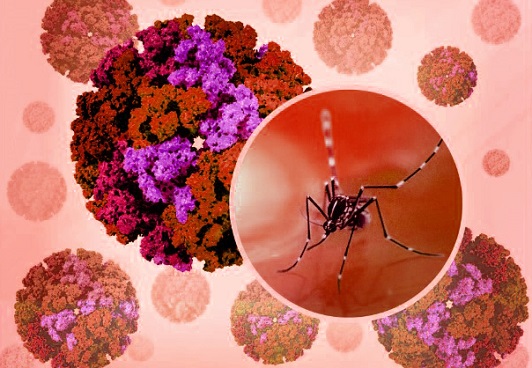Nikhil Prasad Fact checked by:Thailand Medical News Team Oct 06, 2025 1 month, 2 weeks, 1 day, 2 hours, 15 minutes ago
Medical News: New Warning from WHO: More Adaptable Viruses Emerging
The World Health Organization (WHO) has issued a warning about new lineages of the chikungunya virus that carry a particular genetic change — the E1 226V mutation. These mutated viruses may spread more easily in certain mosquito species and could pose a higher risk in parts of the world where such mosquitoes live. The alert is based on recent surveillance and genetic studies.
 WHO Warns of Chikungunya Virus Lineages with The E1 226V Mutation
WHO Warns of Chikungunya Virus Lineages with The E1 226V Mutation
In this
Medical News report, WHO notes that this mutation has been detected in circulating virus strains and stresses the need for countries to strengthen surveillance, vector control, and preparedness efforts. The researchers and public health teams warning about this come from a broad group of institutions, including WHO itself and national health and research agencies across affected countries.
What Is the E1 226V Mutation — and Why It Matters
Chikungunya virus is carried by Aedes mosquitoes (especially Aedes aegypti and Aedes albopictus) and causes fever, joint pain, rash, and sometimes long-lasting arthritic symptoms. Scientists have long known that a single change in the virus’s envelope protein — from an alanine (A) to a valine (V) at position 226 (hence “E1-A226V”) — can make it better able to replicate and transmit via Aedes albopictus mosquitoes. Laboratory experiments support this: viruses with the E1-A226V mutation infect Aedes albopictus more easily, spread to mosquito salivary glands more efficiently, and are more likely to be transmitted to hosts when compared to viruses without that mutation. Because Aedes albopictus is common even in temperate and subtropical zones (beyond purely tropical regions), a virus adapted for transmission by that mosquito has a greater chance of spreading in new areas.
What WHO Observed and Advised
In its outbreak news release, WHO reports that countries in the African region have started detecting chikungunya cases again in 2025, with support from WHO and partner organizations. Key response measures include strengthening case detection and surveillance, boosting vector control through removing breeding sites and fogging, educating communities on protection such as using repellents and eliminating stagnant water, and advising health services to be ready to care for chikungunya patients. WHO also points out that, although two chikungunya vaccines have secured regulatory approval in some places, these are not yet widely available or in broad use globally. Thus, for now, preventing mosquito exposure and controlling mosquito populations remain crucial.
What Genetic Studies Reveal About the Mutation’s Spread
Genomic surveillance and evolutionary analyses have offered more insight into how the E1 226V mutation has evolved and spread. In earlier chikungunya outbreaks, the E1-A226V mutation was found in many virus strains, especially in the Indian Ocean lineage of the East, Central, and South African (ECSA) genotype, facilit
ating transmission via Aedes albopictus. Over time, new sub-lineages of chikungunya have emerged with different sets of mutations that seem adapted to Aedes aegypti. However, re-emergence or detection of the E1-226V mutation in circulating viruses signals that the older “albopictus-friendly” variant may still have an advantage under certain ecological or vector conditions. In Thailand, past outbreaks in 2008–2009 and 2013 involved chikungunya strains harboring the E1-A226V mutation. Molecular clock and phylogenetic modeling suggest that virus lineages with adaptive mutations can spread across regions, evolve divergently, and sometimes re-invade areas where they had diminished. These genetic insights underline that chikungunya virus is dynamic, continuing to evolve under pressures from mosquito ecology and human movement.
What It Means for Communities & Public Health
Because the E1 226V mutation can confer an advantage for mosquito transmission, especially when Aedes albopictus is abundant, regions with that mosquito must be on alert. That includes many parts of Asia, Africa, and increasingly even subtropical zones beyond the tropics. People should take preventive steps such as using mosquito repellents, wearing long sleeves, installing screens, eliminating standing water, and seeking medical attention early when symptoms like fever, joint pain, or rash appear. Public health authorities need to maintain and expand mosquito surveillance and virus genetic monitoring to detect spread early and mount control measures before outbreaks grow. In addition, research into vaccines, antiviral treatments, and mosquito control methods must remain a priority, especially in areas with evolving virus lineages.
Conclusion
The detection of chikungunya virus lineages with the E1 226V mutation marks a concerning development as it suggests that the virus may regain or maintain a transmission advantage through Aedes albopictus, potentially enabling spread in regions where that mosquito thrives. Genetic studies confirm that chikungunya is no static foe — it evolves, adapts, and shifts between mosquito hosts. Vigilance, strong public health systems, and community action are essential to stay ahead of outbreaks.
References:
https://www.who.int/emergencies/disease-outbreak-news/item/2025-DON581
https://journals.plos.org/plospathogens/article?id=10.1371%2Fjournal.ppat.0030201
https://pmc.ncbi.nlm.nih.gov/articles/PMC6152176/
https://www.sciencedirect.com/science/article/pii/S1201971221007645
https://www.mdpi.com/2076-2607/10/2/354
https://pmc.ncbi.nlm.nih.gov/articles/PMC12398651/
https://virologyj.biomedcentral.com/articles/10.1186/1743-422X-10-174
For the latest on Chikungunya, keep on logging to Thailand
Medical News.
Read Also:
https://www.thailandmedical.news/news/chikungunya-infection-can-cause-rare-immune-blood-disorder
https://www.thailandmedical.news/news/thailand-medical-researchers-find-link-between-blood-group-o-and-higher-risk-of-chikungunya
https://www.thailandmedical.news/news/new-concerns-in-pune-india-as-chikungunya-survivors-face-long-term-health-issues
